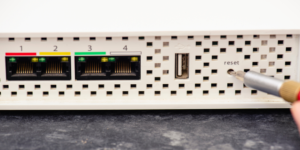Are you tired of experiencing slow internet speeds and frustrating connectivity issues? If so, you’re not alone. Many people struggle with a weak Wi-Fi signal, which can hinder their online activities and productivity. However, fret not! In this article, we will delve into effective strategies to boost your Wi-Fi signal, ensuring a faster and more reliable internet connection. So, let’s dive in and optimize your wireless network!
1. Position Your Router Strategically to Boost Wi-Fi Signal
The positioning of your router plays a crucial role in optimizing the signal coverage and range of your Wi-Fi network. By strategically placing your router, you can ensure a stronger and more reliable Wi-Fi signal throughout your home or office. Consider the following tips for positioning your router:
Central Location: Maximize Signal Propagation
Position your router in a central area of your space to maximize signal propagation. By placing it in a central location, the Wi-Fi signal can reach all areas more evenly, reducing the chances of weak spots or dead zones. Choose a spot that allows the signal to spread in all directions, minimizing obstructions.
Elevate the Router: Avoid Ground Interference
Elevating your router can help avoid interference caused by objects on the ground. Place the router on a higher shelf, desk, or mount it on a wall. By doing so, you can enhance the signal’s reach and reduce potential signal degradation caused by furniture or other obstacles on the ground.

Minimize Obstructions: Clear the Path for the Signal
Keep your router away from obstructions that can block or weaken the Wi-Fi signal. Walls, furniture, and other physical barriers can hinder the signal’s strength and range. By positioning the router away from these obstructions, you allow the signal to travel more freely, resulting in improved connectivity.
Distance from Interfering Objects: Reduce Signal Interference
Certain objects and devices can interfere with the Wi-Fi signal, leading to a weaker connection. Keep your router away from appliances, electronics, and metal objects. Additionally, microwave ovens and cordless phones operate on similar frequencies as Wi-Fi, so it’s important to position the router away from them to minimize interference.
Antenna Orientation: Optimize Signal Direction
If your router has adjustable antennas, consider orienting them for optimal signal direction. Experiment with different angles and orientations to find the configuration that provides the best signal strength and coverage. Adjusting the antennas can help focus the signal in specific areas, improving connectivity where you need it the most.
Multiple Access Points: Enhance Coverage in Large Spaces
For larger spaces or multi-story buildings, consider using multiple access points. By installing additional routers or Wi-Fi extenders strategically, you can extend the coverage and ensure a stronger signal throughout the entire area. This approach helps eliminate dead zones and provides seamless connectivity, even in expansive environments.
Positioning your router strategically is the first step toward optimizing your Wi-Fi signal. By following these guidelines and considering the unique layout of your space, you can significantly boost your Wi-Fi signal coverage and range, resulting in a more robust and reliable wireless connection.
| Call 866-861-4084 for Internet Deals |
2. Update Firmware and Security Settings
To ensure your router operates at its best and safeguards your network from potential vulnerabilities, it’s crucial to regularly update its firmware and configure the necessary security settings. Here’s a closer look at each aspect:
Firmware Updates: Unleash New Features and Enhancements
Router manufacturers frequently release firmware updates to address bugs, improve performance, and introduce new features. By updating your router’s firmware, you can benefit from these advancements and ensure the best possible performance. Here’s how to update the firmware:
- Check the Manufacturer’s Website: Visit the website of your router’s manufacturer and navigate to the support or downloads section. Look for the latest firmware version available for your specific router model.
- Download the Firmware: Download the firmware file onto your computer or device, ensuring it matches your router’s make and model.
- Backup Router Settings: Before proceeding with the update, it’s essential to back up your router’s current settings. This precaution allows you to restore your configurations in case any issues arise during the update process.
- Access Router Settings: Open a web browser and enter your router’s IP address in the address bar. This address is usually mentioned in the router’s manual or marked on the device itself. Provide your router’s admin credentials to access the settings page.
- Locate Firmware Update Option: Within the router settings page, navigate to the firmware update section. This section may be labeled differently depending on the router’s manufacturer.
- Upload the Firmware File: Browse for the firmware file you downloaded earlier and upload it to the router. Follow the on-screen instructions provided by your router’s interface to complete the update process. Ensure the router remains connected to a stable power source throughout the update.
- Restart the Router: After the update is complete, restart your router to ensure the changes take effect. This step finalizes the firmware installation and allows the router to optimize its performance based on the updated software.
Regularly checking for and installing firmware updates keeps your router equipped with the latest improvements, bug fixes, and security patches, ensuring optimal performance and protection against potential vulnerabilities.

Security Settings: Fortify Your Network against Threats
Securing your Wi-Fi network is essential to protect your data and maintain a safe online environment. Follow these steps to configure your router’s security settings:
- Access Router Settings: Using a web browser, enter your router’s IP address in the address bar, and log in with the admin credentials.
- Change Default Password: Upon accessing the settings, change the default password of your router to a strong and unique one. A strong password should consist of a combination of letters, numbers, and special characters. Avoid using easily guessable information such as your name or address.
- Encryption Settings: Enable WPA2 or WPA3 encryption, which are the most secure options available. These encryption protocols protect your Wi-Fi network by encrypting data transmitted between devices and the router, making it difficult for unauthorized individuals to intercept and access your information.
- Network Name (SSID) Visibility: Consider hiding your network’s SSID (Service Set Identifier) to prevent it from being visible to nearby devices. This adds an extra layer of security by making your network harder to detect, but keep in mind that manually connecting to the network becomes necessary for new devices.
- Guest Network: If your router supports it, set up a separate guest network for visitors. This network provides internet access but isolates guest devices from your main network, ensuring that potential security risks from guest devices are contained and don’t compromise your primary network.
- Firewall Configuration: Enable the built-in firewall on your router, if available. Firewalls act as a barrier between your network and the internet, monitoring incoming and outgoing traffic for potential threats and blocking unauthorized access attempts.
3. Optimize Wi-Fi Channel and Bandwidth:
Optimizing the Wi-Fi channel and bandwidth settings of your router can boost your Wi-Fi signal quality and speed of your wireless network. By making the right adjustments, you can minimize interference and ensure a smoother and more reliable connection. Let’s explore the steps to optimize these settings:
Choose the Right Wi-Fi Channel
Wi-Fi channels determine the frequency range on which your router broadcasts its signal. To minimize interference from neighboring networks, follow these steps to select the optimal Wi-Fi channel:
- Wi-Fi Analyzer: Use a Wi-Fi analyzer tool to scan for nearby networks and identify the channels with the least congestion. These tools provide valuable information about the Wi-Fi signals in your vicinity, including their strengths and channel allocations.
- Access Router Settings: Open a web browser, enter your router’s IP address in the address bar, and log in using the admin credentials.
- Navigate to Wireless Settings: Within the router settings page, locate the wireless settings or Wi-Fi configuration section.
- Select the Best Channel: Based on the information obtained from the Wi-Fi analyzer, choose a channel that is less crowded. Ideally, select a channel that has the least overlapping networks.
- Apply Changes: Save the settings, and the router will adjust its broadcasting channel accordingly. This optimization reduces interference and enhances the quality of your Wi-Fi signal.

Allocate Bandwidth for Optimal Performance
If you have multiple devices connected to your Wi-Fi network, allocating bandwidth effectively can ensure that each device receives the necessary speed and performance. Follow these steps to prioritize bandwidth allocation:
- Access Router Settings: Open a web browser, enter your router’s IP address in the address bar, and log in using the admin credentials.
- QoS (Quality of Service) Settings: Navigate to the Quality of Service or QoS settings section within the router settings page.
- Enable QoS: Enable the QoS feature, if available. QoS allows you to prioritize certain types of network traffic, ensuring that critical applications or devices receive the necessary bandwidth for optimal performance.
- Set Priority: Determine the devices or applications that require higher priority and allocate more bandwidth to them. For example, you may want to prioritize streaming devices, online gaming consoles, or video conferencing applications.
- Save Changes: Once you have configured the bandwidth allocation, save the settings to apply the changes.
By optimizing the Wi-Fi channel and allocating bandwidth effectively, you can reduce interference from neighboring networks and ensure that critical devices or applications receive the necessary speed and performance. These adjustments enhance the overall quality and speed of your Wi-Fi connection, resulting in a smoother and more enjoyable online experience.
4. Use Wi-Fi Range Extenders or Mesh Systems
Wi-Fi range extenders and mesh systems are effective solutions for extending the coverage of your Wi-Fi network, particularly in larger spaces or areas with multiple floors. These devices help eliminate dead zones and ensure a strong and reliable connection throughout your home or office. Let’s delve into how Wi-Fi range extenders and mesh systems work:
Wi-Fi Range Extenders: Boost Your f Your Wi-Fi Signal
Wi-Fi range extenders, also known as Wi-Fi boosters or repeaters, amplify your existing Wi-Fi signal and extend its coverage to areas with weak or no connectivity. Here’s how you can utilize Wi-Fi range extenders:
- Placement: Position the Wi-Fi range extender in a location that is within the range of your existing Wi-Fi signal but closer to the areas with weak coverage. The extender will pick up the signal and rebroadcast it, effectively extending the coverage.
- Setup Process: Most Wi-Fi range extenders come with a setup wizard that guides you through the installation process. Typically, you’ll need to connect the extender to your existing Wi-Fi network and follow the instructions provided in the user manual or on-screen prompts.
- Configuration: Once the range extender is connected to your Wi-Fi network, you may have the option to configure additional settings, such as network name (SSID) and password. It’s recommended to use the same network name as your main router to maintain a seamless transition between the two.
- Testing and Placement Adjustment: After the initial setup, test the Wi-Fi signal strength in the areas that previously had poor coverage. If needed, reposition the range extender for optimal signal extension. Experiment with different placements until you achieve the desired coverage and signal strength.
Wi-Fi range extenders effectively increase the range of your Wi-Fi network by rebroadcasting the existing signal, making them a cost-effective solution for extending coverage in specific areas of your home or office.

Mesh Systems: Seamless Coverage for Large Spaces
Mesh Wi-Fi systems consist of a main router and multiple satellite devices, creating a mesh network that blankets your entire space with seamless Wi-Fi coverage. Unlike range extenders, mesh systems utilize multiple access points to distribute the Wi-Fi signal evenly, resulting in consistent performance throughout the entire area. Here’s how mesh systems work:
- Setup and Placement: Begin by setting up the main router and connecting it to your modem. Place the satellite devices strategically throughout your space, ensuring they are within range of both the main router and other satellites.
- Configuration: Most mesh systems come with dedicated mobile apps or web interfaces that simplify the configuration process. Follow the on-screen instructions to create a mesh network, establish the connection between the main router and satellites, and configure network settings.
- Adaptive Routing: Mesh systems utilize adaptive routing algorithms to determine the optimal path for data transmission. This dynamic routing ensures that data packets are efficiently delivered through the fastest and least congested route, enhancing overall network performance.
- Seamless Roaming: One of the key advantages of mesh systems is seamless roaming. As you move throughout your space, your devices automatically connect to the nearest access point with the strongest signal, ensuring uninterrupted connectivity.
Mesh Wi-Fi systems provide comprehensive coverage and eliminate dead zones by seamlessly extending your Wi-Fi network using multiple access points. This makes them an ideal solution for large homes, multi-story buildings, or areas with challenging architectural layouts
5. Reduce Interference from Other Devices
Interference from other devices can disrupt your Wi-Fi signal and degrade its performance. By identifying and mitigating sources of interference, you can enhance the stability and reliability of your Wi-Fi connection. Here are some strategies to reduce interference:
Position Your Router Strategically
The placement of your router plays a crucial role in minimizing interference and maximizing signal strength. Consider the following tips:
- Central Location: Position your router in a central location within your home or office. This allows the Wi-Fi signal to propagate evenly in all directions, reaching a wider coverage area.
- Elevated Position: Place the router on a higher shelf, table, or wall-mount to ensure better signal propagation and reduce obstructions. Avoid placing it on the floor or behind furniture that can obstruct the signal.
- Avoid Interference: Keep the router away from devices that emit electromagnetic signals, such as cordless phones, microwave ovens, baby monitors, and Bluetooth devices. These devices can interfere with the Wi-Fi signal and cause disruptions.
- Antenna Orientation: Adjust the orientation of the router’s antennas for optimal signal strength. Experiment with both vertical and horizontal positions to determine which configuration provides the best coverage.

Utilize 5GHz Frequency Band
Most modern routers support dual-band functionality, operating on both the 2.4GHz and 5GHz frequency bands. The 2.4GHz band is commonly used and susceptible to interference from other devices, while the 5GHz band offers faster speeds and reduced interference. To leverage the benefits of the 5GHz band:
- Check Router Compatibility: Ensure that your router supports the 5GHz band. Refer to the router’s manual or specifications to verify its capabilities.
- Connect to 5GHz Network: Access your router’s settings and enable the 5GHz network. Give it a distinct name (SSID) to differentiate it from the 2.4GHz network.
- Connect Compatible Devices: Connect devices that support the 5GHz band to the respective network. Devices such as modern smartphones, laptops, and tablets often have dual-band capability and can take advantage of the faster and less congested 5GHz frequency.
Change Wi-Fi Channel
Wi-Fi channels can become crowded due to neighboring networks operating on the same or overlapping channels. By changing the Wi-Fi channel, you can minimize interference from other networks. Follow these steps:
- Wi-Fi Analyzer: Use a Wi-Fi analyzer tool to scan for nearby networks and identify the least congested channels.
- Access Router Settings: Open a web browser, enter your router’s IP address in the address bar, and log in using the admin credentials.
- Wireless Settings: Locate the wireless settings or Wi-Fi configuration section within the router settings page.
- Choose a Less Congested Channel: Based on the information obtained from the Wi-Fi analyzer, select a channel that has the least interference and congestion.
- Apply Changes: Save the settings, and the router will adjust its broadcasting channel accordingly.
By selecting a less congested Wi-Fi channel, you can minimize interference from neighboring networks and improve the stability and performance of your Wi-Fi signal.
Powerline Adapters and Ethernet Connections
In situations where wireless connectivity is challenging or prone to interference, powerline adapters or Ethernet connections can provide a stable and reliable alternative. Powerline adapters use your existing electrical wiring to transmit data signals, while Ethernet connections offer a direct wired connection. Consider these options for devices that require a stable connection, such as gaming consoles, smart TVs, or desktop computers.
By implementing these strategies to reduce interference, you can optimize the stability and performance of your Wi-Fi signal. Positioning your router strategically, utilizing the 5GHz frequency band, changing Wi-Fi channels, and considering alternative connectivity options will enhance your overall Wi-Fi experience.
6. Regularly Restart Your Router
Regularly restarting your router is a simple yet effective practice that can help maintain optimal performance and resolve common connectivity issues. Over time, routers can experience minor glitches or memory buildup, impacting their performance.
Restarting your router periodically can alleviate these issues and ensure a smooth and reliable Wi-Fi experience. Consider the following benefits and steps for restarting your router:
Benefits of Restarting Your Router
Clearing Memory and Cache: Restarting your router clears temporary files, cache, and memory, which can accumulate over time and affect performance. By doing so, you give your router a fresh start and enable it to operate at its best.
Resolving Network Congestion: Restarting your router helps alleviate network congestion caused by prolonged usage or multiple connected devices. This can lead to improved bandwidth allocation and reduced latency.
Updating Firmware: Some routers automatically check for firmware updates upon reboot. Regular restarts ensure that your router stays up to date with the latest firmware, which often includes bug fixes, security enhancements, and performance optimizations.

Steps to Restart Your Router
Power Down: Locate the power source of your router and turn it off. You may need to unplug the power adapter from the electrical outlet or use the power button, if available.
Disconnect Cables: Once the router is powered down, disconnect any Ethernet cables connected to the router. This includes the cable coming from your modem, as well as any other devices connected directly to the router.
Wait for a Few Minutes: Give your router a brief break by waiting for approximately 1-2 minutes. This allows any residual charge to dissipate and ensures a fresh start upon reboot.
Power Up: After the waiting period, reconnect the power adapter or turn on the power button to restart the router. Wait for the router to fully boot up and establish a connection with your modem.
Reconnect Cables: Once the router has restarted, reconnect the Ethernet cables that were previously disconnected. Ensure that the cables are securely plugged into the appropriate ports.
Verify Connectivity: Once your router is up and running, check for internet connectivity by connecting to your Wi-Fi network on your devices. Test the connection speed and ensure that all devices are able to access the internet.
Establish a Restart Schedule
To maintain consistent performance, consider establishing a regular restart schedule for your router. Depending on your usage patterns and the stability of your network, you can opt to restart your router once a week, bi-weekly, or monthly. This proactive approach helps prevent potential issues and keeps your router operating smoothly.
| Call 866-861-4084 for Internet Deals |
7. Upgrade Your Router
Upgrading your router is a proactive step towards boosting your Wi-Fi signal and enjoying advanced features that can significantly improve performance. As technology evolves, newer router models offer better speeds, increased range, improved security, and enhanced capabilities. Consider the following aspects when upgrading your router:
Faster Wireless Standards and Speeds
Older router models may operate on outdated wireless standards such as 802.11n or even earlier versions. Upgrading to a router that supports the latest standards, such as 802.11ac or 802.11ax (Wi-Fi 6), can provide faster speeds and better overall performance. These newer standards utilize advanced technologies to deliver improved data transfer rates and handle multiple devices simultaneously.
When selecting a new router, look for one that supports the latest wireless standards and offers higher maximum speeds. This upgrade will ensure that your Wi-Fi network can handle bandwidth-intensive activities like streaming high-definition videos, online gaming, or file transfers without lag or buffering.
Increased Range and Coverage
If you frequently encounter dead zones or areas with weak Wi-Fi signals, upgrading to a router with improved range and coverage can address these issues. Newer router models often feature stronger antennas, beamforming technology, or mesh capabilities to extend the reach of the Wi-Fi signal and provide consistent coverage throughout your space.
Consider routers with multiple antennas or mesh systems that include satellite devices for broader coverage. These options distribute the Wi-Fi signal more effectively, minimizing dead zones and ensuring a reliable connection in every corner of your home or office.
Enhanced Security Features
Network security is a critical aspect of maintaining a safe and protected Wi-Fi environment. Upgrading your router allows you to benefit from enhanced security features and protocols that keep your network and connected devices secure from potential threats.
Look for routers that support the latest security standards, such as WPA3, which provides stronger encryption and protection against unauthorized access. Additionally, routers with built-in firewalls, VPN (Virtual Private Network) support, and advanced security settings offer additional layers of defense against malicious activities.
Advanced Management and Configuration Options
Newer router models often come with user-friendly interfaces, mobile apps, or web-based dashboards that simplify the management and configuration process. These intuitive interfaces allow you to customize various settings, monitor network activity, and troubleshoot issues more efficiently.
Consider routers that offer advanced management features like parental controls, guest networks, Quality of Service (QoS) settings, and traffic prioritization. These options provide greater control over your network and enable you to optimize performance based on your specific needs.
Gigabit Ethernet Ports and USB Connectivity
If you rely on wired connections for certain devices or require high-speed data transfer between devices on your local network, upgrading to a router with Gigabit Ethernet ports can significantly enhance wired performance. Gigabit Ethernet ports provide faster and more reliable connections for devices such as desktop computers, gaming consoles, or network-attached storage (NAS) devices.
Additionally, routers with USB ports offer the flexibility to connect external storage devices or printers, allowing you to create network-attached storage solutions or share resources across your network. By upgrading your router to a model that incorporates advanced technology and features, you can experience faster speeds, increased coverage, enhanced security, and improved management options. Research and choose a router that aligns with your specific requirements, and enjoy a more efficient and robust Wi-Fi network.
Conclusion
A strong and reliable Wi-Fi signal is essential for seamless internet connectivity. With the abovementioned actions, you can significantly boost your Wi-Fi signal and enjoy faster speeds and improved connectivity for sure.

Jason ‘Jace’ Cooper is a digital maestro who’s journey in the dynamic realms of tech, internet, and gaming has been fueled by a passion for innovation. Crafting insightful narratives about the industry, Jace transforms complex topics into compelling tales that captivate and inform.